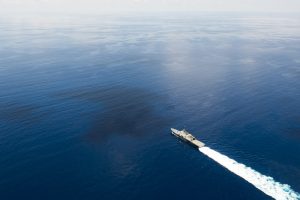On December 30, the littoral combat ship USS Fort Worth (LCS 3) arrived in Phuket, Thailand for the first time as part of a scheduled port visit.
According to the U.S. Navy, as with regular port visits, the ship’s crew was afforded the opportunity to participate in various activities including a community service event as well as tours.
“I first visited Phuket 15 years ago and it’s great to be back,” Cmdr. Michael Atwell, the Fort Worth’s commanding officer, told Military.com. “I know our Sailors will enjoy it here and this is a great way for them to be good ambassadors of the United States while meeting the warm and friendly people of Thailand.”
More broadly, the visit was another demonstration of the vessel’s growing involvement in the Asia-Pacific. With the United States aiming for four LCS to be rotationally deployed in Singapore by 2017, Washington has looked to integrate the Fort Worth into its activities in the region ranging from exercises to maintenance operations. Indeed, during her first full year operating forward, the Fort Worth participated in nine bilateral and multilateral exercises with allies and partners ranging from Korea to India and conducted 12 port visits.
As part of an effort to increase integration between the United States and partner nations in the Asia-Pacific, the Fort Worth embarked one naval officer from Sri Lanka and one coast guard officer from the Maldives prior to the port visit to Phuket. The embarked officers reportedly both watched and participated in underway operations with the crew, gaining firsthand knowledge of what life is like on board the LCS.
The LCS was originally seen by the U.S. Navy as a fast, agile ship designed to operate in shallow waters and tackle asymmetric “anti-access” threats like mines, quiet diesel submarines and fast surface craft. But it has been met with controversy due to its high costs as well as design issues that critics say make it too vulnerable. Last month, U.S. Defense Secretary Ashton Carter ordered the U.S. Navy to reduce the number of LCS to be built from 52 to 40.

































